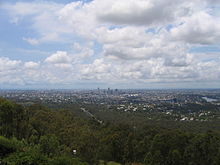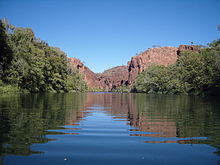Regions in Queensland
The regions of Queensland are officially designated geographic areas in the Australian state of Queensland . Because of its large area and decentralized population, Queensland is divided into regions for statistical and administrative purposes. Each region has a different economy, population, geography, flora and fauna and a different climate. The respective government agencies and population groups differ in their cultural and official views and definitions.
overview
Different ministries define their administrative tasks differently in the regions. The Office of Economic and Statistical Research set up by the government distinguishes eleven regions. These are located from south to north as follows:
- Brisbane
- Moreton
- Darling Downs
- South West Queensland
- Central West
- Wide Bay-Burnett
- Fitzroy
- Mackay
- Northern
- North West
- Far North
The above subdivision is also used by the Australian Bureau of Statistics . Sometimes several of these regions are linked together and combined into one region, for example Mackay and Fitzroy together form Central Queensland and Brisbane and Moreton South East Queensland . Smaller regions also exist in the defined regions, such as the Torres Strait Islands or the Whitsunday Islands .
South East Queensland
- Main article : → South East Queensland
South East Queensland is generally considered to be a single region. The region includes Brisbane and Moreton as two statistical regions. It has a population of 2,847,029 people, or 66.3% of the population of Queensland. The area includes Brisbane, the state's capital, as well as the Gold Coast , Sunshine Coast , Ipswich and the Lockyer Valley . This region is the main administrative and economic center of Queensland and is the focus of tourism.
Brisbane

The Brisbane region includes the metropolitan area of Brisbane, which is centered around the city of Brisbane and includes the local areas of the administrations of Logan , Redland , Moreton Bay and Ipswich. The metropolitan area had a population of 1,945,639 in 2008, representing 45% of the state's population. It is the economic and administrative center and includes Queensland's largest international and domestic airport.
Moreton
The Moreton region is for the most part only used for statistical purposes and is not otherwise in general use. The area is popularly considered part of South East Queensland and does not include the metropolitan area of Brisbane, namely the Sunshine Coast , the City of Gold Coast and the West Moreton sub-region , which consists of the Lockyer Valley , Scenic Rim and Somerset government areas .
The Gold Coast and Sunshine Coast region lie to the south and north of Brisbane, both of which are Queensland's most popular tourist areas and are home to many hotels and resorts. Each region has its airport, which is mainly frequented by tourists. The other parts of the region are inland, west of Brisbane, and are mostly rural.
This region has a population of 901,390 people which represents 21.0% of Queensland's population.
Darling Downs
- Main article : → Darling Downs
The Darling Downs region is about 160 km west of Brisbane and consists of the fertile agricultural area west of the Great Dividing Range . It is located south of the New South Wales border and is centered around Toowoomba . The region covers an area of 90,246 km² and includes the local government areas of Toowoomba, Goondiwindi , Southern Downs and Western Downs . In 2008 the region had a population of 231,599 people.
South west
South West Queensland is on the border of New South Wales and South Australia and is sparsely populated. It includes the local government areas of Maranoa , Balonne , Bulloo , Murweh , Paroo and Quilpie . The major cities in the region are Roma , Mitchell , St George , Cunnamulla , Charleville , Surat and Thargomindah . The region is home to livestock farming, cotton growing, and natural gas and opal deposits . In 2008 the region had a population of 26,150 people and an area of 319,883 km².
Central West
- Main article : → Central West Queensland
The Central West Region borders South Australia and the Northern Territory . It consists of the government areas of Barcaldine , Barcoo , Blackall-Tambo , Boulia , Diamantina , Longreach and Winton . Although the region consists of the vast area of 374,743 km², it only has a population of 12,256 people. The area is called Channel Country .
Wide Bay-Burnett
- Main article : → Wide Bay-Burnett
The Wide Bay-Burnett region is north of the Darling Downs and north of the Sunshine Coast and covers an area of 52,377 km². It consists of the government areas of Bundaberg Region , Fraser Coast Region , Gympie Region , North Burnett Region and South Burnett Region . Main centers are Bundaberg , Gympie , Hervey Bay , Kingaroy and Maryborough . The region is home to numerous sugar cane mills and a significant tourism industry that includes Fraser Island , a popular tourist destination and the world's largest sand island. In 2008 the region had a population of 276,752 people.
Central Queensland
Fitzroy
The Fitzroy area has its main centers with Rockhampton and Gladstone , in coastal areas and popular holiday resorts such as Agnes Water and Seventeen Seventy, and the hinterland areas further west. The region's economy is heavily dominated by coal mining and livestock farming. There is a significant aluminum smelter in Gladstone. The region has a population of 187,916 people and covers an area of 122,971.5 km².
Mackay
The Mackay region is centered around Mackay and extends 300 km inland. It includes the Whitsunday Islands and the coastal towns of Proserpine , Bowen and Sarina . The coastal areas are densely covered by sugar cane plantations, while the less densely populated inland has numerous mining settlements.
North Queensland
- Main article : → North Queensland
North Queensland is a coastal region centered around Townsville . Townsville is the region's major port serving the export of Mount Isa mines and cattle exports from the coast and inland. The region contains numerous loading stations for sugar near Lucinda in the north of the region. There are also inland cities such as Charters Towers and the coastal cities of Ayr , Home Hill and Ingham .
North West

The region is also known as the Gulf Country , the North West region lies along the coast of the Gulf of Carpentaria . The area is mostly arid or savanna . The most important cities in the region are Mount Isa with a population of around 25,000 people. Other populous centers are Burketown , Cloncurry , Doomadgee , Kowanyama , Mornington Island and Normanton .
The region has 35,779 people, less than 1% of the state's population. 28.1% are Aboriginal . The region's economy is dominated by the zinc, copper, silver and lead mines around Mount Isa . Another important industry is the livestock industry. The Region covers an area of 308,098 km².
Far North
- Main article : → Far North Queensland
The Far Northern Region covers most of the Cape York Peninsula and extends to Torres Strait on the northernmost part of the state.
The largest population and administrative center of the region is in Cairns . Other major centers are Cooktown , Atherton Tableland , Weipa and the Torres Strait Islands. The region consists of numerous Aboriginal and farming settlements. In 2003 the region counted 231,494 people, 117,531 of whom live in Cairns.
Important economic activities in the region are tourism, animal husbandry, agriculture with sugar cane and tropical fruit cultivation, mineral sand mining and bauxite mining .
Further definitions
Other names are also in popular use, for example by other government agencies and various location maps of the regions of Queensland. There are smaller regions in the state that are not used for statistical purposes, but which are defined in their region as terms for their geography, economy or demographic characteristics. Other regions in Queensland are:
- Tropical Queensland , the area, begins at 23.5 degrees northbound.
- Tropical North Queensland is located in the north of the state near Mackay.
- Outback is commonly referred to as the arid interior of Queensland.
- Whitsunday Islands , a group of islands in the Mackay region, a popular tourist destination. The region includes the coastal community of Airlie Beach and is sometimes called Proserpine .
- Torres Strait Islands is located between the northern tip of Queensland and Papua New Guinea
- Atherton Tableland , a fertile agricultural district in Far North Queensland , in the Cairns hinterland.
- Granite Belt , an area in southeast Queensland centered around the city of Stanthorpe .
- Border Rivers is close to the border between New South Wales and Queensland.
- Capricorn Coast , a section of the Central Queensland coastline.
- Maranoa , a district sometimes called Western Darling Downs but part of South West Queensland.
Individual evidence
- ↑ a b c d Australian Bureau of Statistics : 3218.0 - Regional Population Growth, Australia, 2007-08 - Queensland . April 23, 2009. Retrieved May 30, 2008.
- ^ Australian Bureau of Statistics : 3218.0 - Regional Population Growth, Australia, 2007-08 . April 23, 2009. Retrieved May 30, 2008.


